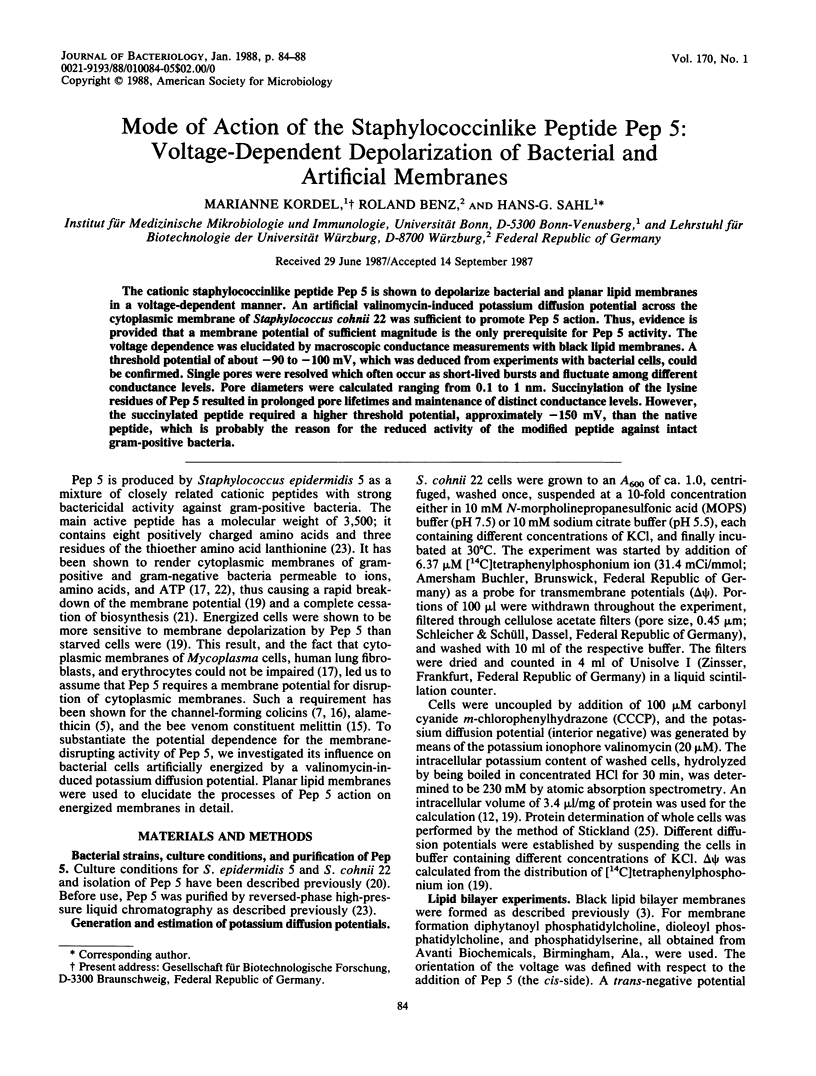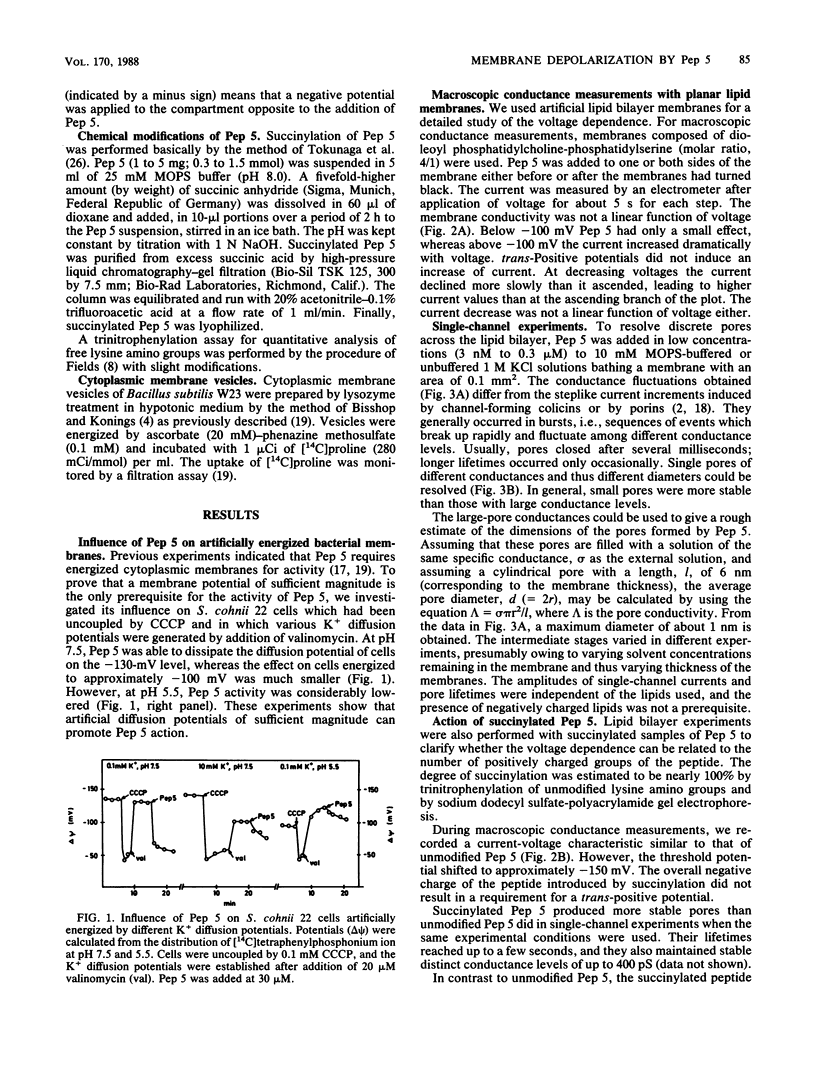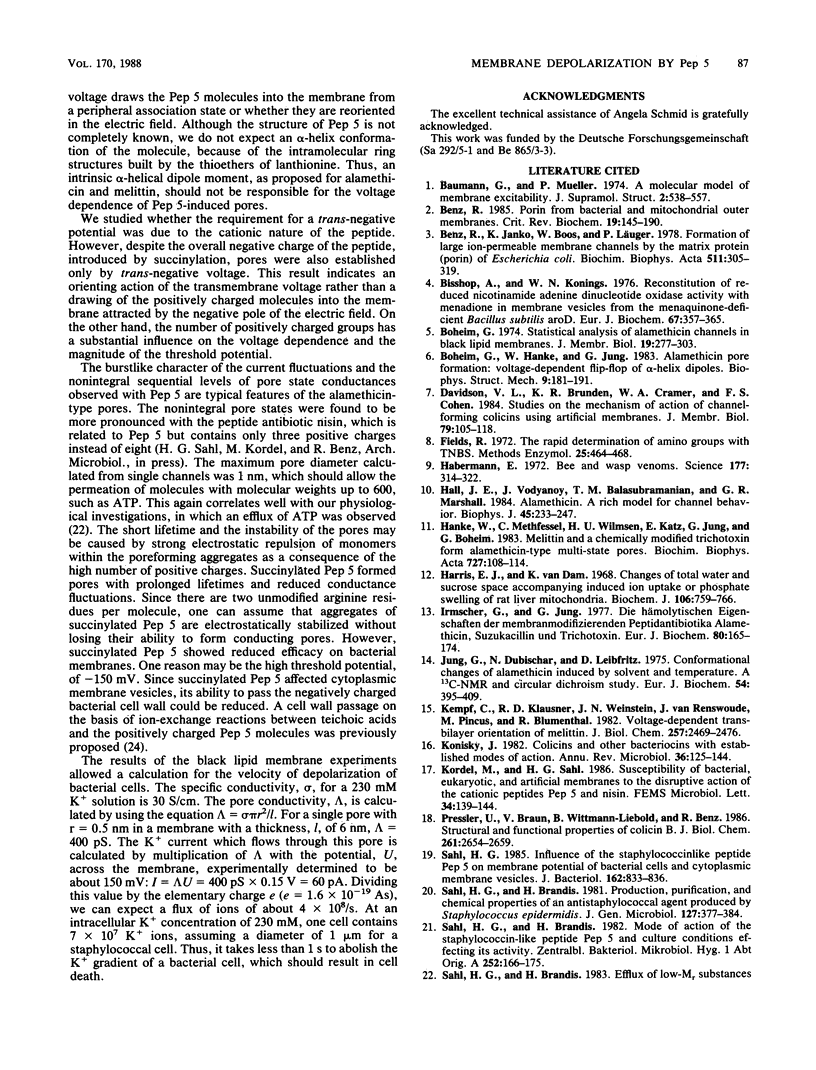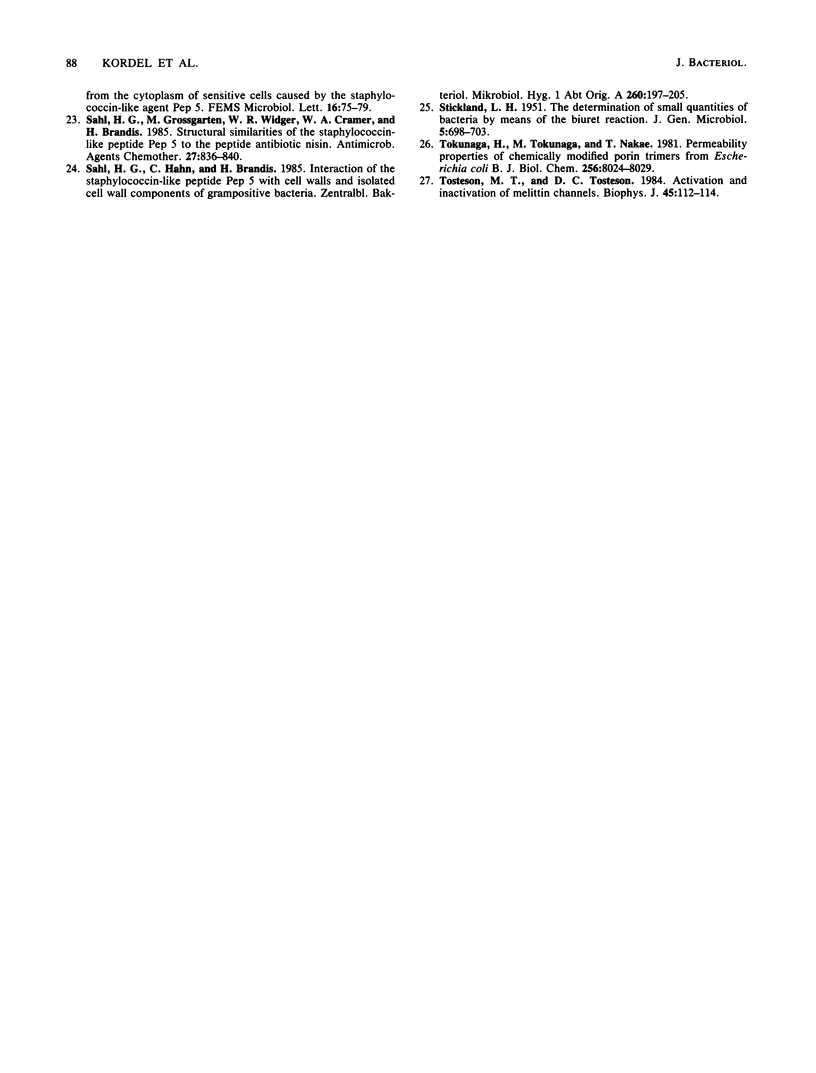Abstract
The cationic staphylococcinlike peptide Pep 5 is shown to depolarize bacterial and planar lipid membranes in a voltage-dependent manner. An artificial valinomycin-induced potassium diffusion potential across the cytoplasmic membrane of Staphylococcus cohnii 22 was sufficient to promote Pep 5 action. Thus, evidence is provided that a membrane potential of sufficient magnitude is the only prerequisite for Pep 5 activity. The voltage dependence was elucidated by macroscopic conductance measurements with black lipid membranes. A threshold potential of about -90 to -100 mV, which was deduced from experiments with bacterial cells, could be confirmed. Single pores were resolved which often occur as short-lived bursts and fluctuate among different conductance levels. Pore diameters were calculated ranging from 0.1 to 1 nm. Succinylation of the lysine residues of Pep 5 resulted in prolonged pore lifetimes and maintenance of distinct conductance levels. However, the succinylated peptide required a higher threshold potential, approximately -150 mV, than the native peptide, which is probably the reason for the reduced activity of the modified peptide against intact gram-positive bacteria.
Full text
PDF




Selected References
These references are in PubMed. This may not be the complete list of references from this article.
- Baumann G., Mueller P. A molecular model of membrane excitability. J Supramol Struct. 1974;2(5-6):538–557. doi: 10.1002/jss.400020504. [DOI] [PubMed] [Google Scholar]
- Benz R., Janko K., Boos W., Läuger P. Formation of large, ion-permeable membrane channels by the matrix protein (porin) of Escherichia coli. Biochim Biophys Acta. 1978 Aug 17;511(3):305–319. doi: 10.1016/0005-2736(78)90269-9. [DOI] [PubMed] [Google Scholar]
- Benz R. Porin from bacterial and mitochondrial outer membranes. CRC Crit Rev Biochem. 1985;19(2):145–190. doi: 10.3109/10409238509082542. [DOI] [PubMed] [Google Scholar]
- Bisschop A., Konings W. N. Reconstitution of reduced nicotinamide adenine dinucleotide oxidase activity with menadione in membrane vesicles from the menaquinone-deficient Bacillus subtilis aro D. Relation between electron transfer and active transport. Eur J Biochem. 1976 Aug 16;67(2):357–365. doi: 10.1111/j.1432-1033.1976.tb10699.x. [DOI] [PubMed] [Google Scholar]
- Boheim G. Statistical analysis of alamethicin channels in black lipid membranes. J Membr Biol. 1974;19(3):277–303. doi: 10.1007/BF01869983. [DOI] [PubMed] [Google Scholar]
- Davidson V. L., Brunden K. R., Cramer W. A., Cohen F. S. Studies on the mechanism of action of channel-forming colicins using artificial membranes. J Membr Biol. 1984;79(2):105–118. doi: 10.1007/BF01872115. [DOI] [PubMed] [Google Scholar]
- Habermann E. Bee and wasp venoms. Science. 1972 Jul 28;177(4046):314–322. doi: 10.1126/science.177.4046.314. [DOI] [PubMed] [Google Scholar]
- Hall J. E., Vodyanoy I., Balasubramanian T. M., Marshall G. R. Alamethicin. A rich model for channel behavior. Biophys J. 1984 Jan;45(1):233–247. doi: 10.1016/S0006-3495(84)84151-X. [DOI] [PMC free article] [PubMed] [Google Scholar]
- Hanke W., Methfessel C., Wilmsen H. U., Katz E., Jung G., Boheim G. Melittin and a chemically modified trichotoxin form alamethicin-type multi-state pores. Biochim Biophys Acta. 1983 Jan 5;727(1):108–114. doi: 10.1016/0005-2736(83)90374-7. [DOI] [PubMed] [Google Scholar]
- Harris E. J., van Dam K. Changes of total water and sucrose space accompanying induced ion uptake or phosphate swelling of rat liver mitochondria. Biochem J. 1968 Feb;106(3):759–766. doi: 10.1042/bj1060759. [DOI] [PMC free article] [PubMed] [Google Scholar]
- Irmscher G., Jung G. Die hämolytischen Eigenschaften der membranmodifizierenden Peptidantibiotika Alamethicin, Suzukacillin und Trichotoxin. Eur J Biochem. 1977 Oct 17;80(1):165–174. doi: 10.1111/j.1432-1033.1977.tb11868.x. [DOI] [PubMed] [Google Scholar]
- Jung G., Dubischar N. Conformational changes of alamethicin induced by solvent and temperature. A 13C-NMR and circular-dichroism study. Eur J Biochem. 1975 Jun;54(2):395–409. doi: 10.1111/j.1432-1033.1975.tb04150.x. [DOI] [PubMed] [Google Scholar]
- Kempf C., Klausner R. D., Weinstein J. N., Van Renswoude J., Pincus M., Blumenthal R. Voltage-dependent trans-bilayer orientation of melittin. J Biol Chem. 1982 Mar 10;257(5):2469–2476. [PubMed] [Google Scholar]
- Konisky J. Colicins and other bacteriocins with established modes of action. Annu Rev Microbiol. 1982;36:125–144. doi: 10.1146/annurev.mi.36.100182.001013. [DOI] [PubMed] [Google Scholar]
- Pressler U., Braun V., Wittmann-Liebold B., Benz R. Structural and functional properties of colicin B. J Biol Chem. 1986 Feb 25;261(6):2654–2659. [PubMed] [Google Scholar]
- STICKLAND L. H. The determination of small quantities of bacteria by means of the biuret reaction. J Gen Microbiol. 1951 Oct;5(4):698–703. doi: 10.1099/00221287-5-4-698. [DOI] [PubMed] [Google Scholar]
- Sahl H. G., Brandis H. Mode of action of the staphylococcin-like peptide Pep 5 and culture conditions effecting its activity. Zentralbl Bakteriol Mikrobiol Hyg A. 1982 Jun;252(2):166–175. [PubMed] [Google Scholar]
- Sahl H. G., Brandis H. Production, purification and chemical properties of an antistaphylococcal agent produced by Staphylococcus epidermidis. J Gen Microbiol. 1981 Dec;127(2):377–384. doi: 10.1099/00221287-127-2-377. [DOI] [PubMed] [Google Scholar]
- Sahl H. G., Grossgarten M., Widger W. R., Cramer W. A., Brandis H. Structural similarities of the staphylococcin-like peptide Pep-5 to the peptide antibiotic nisin. Antimicrob Agents Chemother. 1985 May;27(5):836–840. doi: 10.1128/aac.27.5.836. [DOI] [PMC free article] [PubMed] [Google Scholar]
- Sahl H. G., Hahn C., Brandis H. Interaction of the staphylococcin-like peptide Pep 5 with cell walls and isolated cell wall components of Gram-positive bacteria. Zentralbl Bakteriol Mikrobiol Hyg A. 1985 Oct;260(2):197–205. doi: 10.1016/s0176-6724(85)80115-2. [DOI] [PubMed] [Google Scholar]
- Sahl H. G. Influence of the staphylococcinlike peptide Pep 5 on membrane potential of bacterial cells and cytoplasmic membrane vesicles. J Bacteriol. 1985 May;162(2):833–836. doi: 10.1128/jb.162.2.833-836.1985. [DOI] [PMC free article] [PubMed] [Google Scholar]
- Tokunaga H., Tokunaga M., Nakae T. Permeability properties of chemically modified porin trimers from Escherichia coli B. J Biol Chem. 1981 Aug 10;256(15):8024–8029. [PubMed] [Google Scholar]
- Tosteson M. T., Tosteson D. C. Activation and inactivation of melittin channels. Biophys J. 1984 Jan;45(1):112–114. doi: 10.1016/S0006-3495(84)84130-2. [DOI] [PMC free article] [PubMed] [Google Scholar]


